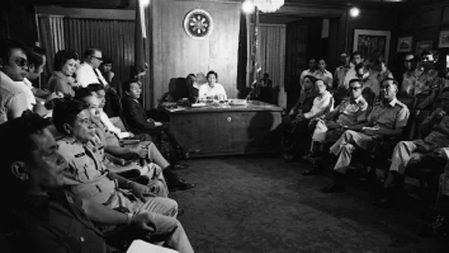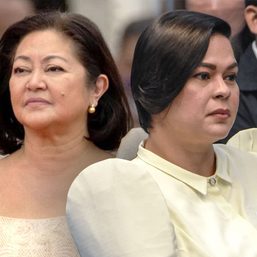SUMMARY
This is AI generated summarization, which may have errors. For context, always refer to the full article.
![[OPINION] ‘Saksi ti Kaunggan’ and national renewal](https://www.rappler.com/tachyon/2022/04/Naitonal-Renewal.jpg)
Elections, regardless of their record of bringing about genuine social, political, and economic change, always inspire hope and optimism. We cast in the ballot our chance to change the course of our nation. With a high risk of a Marcos Jr. victory in the coming presidential election, the stakes for our country’s future could not be higher this time.
Electing change
Both supporters of Robredo and Marcos Jr. see the May elections as a chance to usher in change. In the days before Easter, this change took on Christian dimensions. People talked about a Leni presidency as a kind of renewal, a resurrection of everything good that Filipinos lost during the Duterte regime. Civility, care, compassion. A leadership that not only delivers despite a very limited budget but also is transparent (may resibo na, COA-certified pa). A leadership that inspires people into acts of volunteerism and solidarity. For her supporters, Leni restores one’s faith in Filipinos and hence inspires pride in who they are, in what they can do and achieve.
Supporters of Marcos Jr. have declared “sasama ako sa pagbangon muli.” What is this “pagbangon muli” supposed to be a resurrection of? What are these Filipinos trying to restore? What is their point of reference? It could be 1972, the year Ferdinand Marcos declared Martial Law purportedly to build the New Society whose propaganda song “Bagong Lipunan” is itself enjoying its own revival or resurrection.
“Pagbangon muli” could refer to the Marcos years (1965-1986) when, as the Marcosian fantasy goes, the Philippines experienced its golden age. Post-Marcos, the country went into a progressive decline. It could be February 1986, when the Marcos regime was overthrown. What the anti-Marcos/anti-dictatorship forces saw as the country’s restoration the Marcos loyalists saw as the country’s fall. The election of the dictator’s son — or as his campaign singer declared recently, “ang pagbabalik sa kanyang tahanan” — for the loyalists, marks the country’s resurrection.
This is a perverse redemption story. Or is it?
The profound and deep wound of EDSA 1986
One serious mistake made during and after the democratic transition in 1986 was that nobody paid attention to “loyalist memories” of the Marcos dictatorship. Because the goal was to ensure that a dictatorship does not ever happen again, memory work concentrated on anti-Marcos/ anti-dictatorship remembering and commemoration. We celebrated those who bravely fought or fell victim to the military regime.
There was no attempt to listen to those who saw the event radically differently. Those who saw Marcos as a benevolent figure experienced his overthrow as a profoundly painful and psychically scarring wound. At the very least, leaders, scholars, educators, and policy makers could have learned something from those who saw 1986 EDSA People Power Revolution not as Restoration but as Fall.
The overthrow of Marcos in February 1986 produced the most profoundly culturally grounded, nationalist defense of Marcos and his dictatorship by any Ilokano, or Filipino for that matter. Juan S.P. Hidalgo (1936-2020), who, like F. Sionil Jose, comes from Rosales, Pangasinan, started serializing his novel Saksi ti Kaunggan in the Ilokano-language magazine Bannawag on April 21, 1986, less than two months after the EDSA revolt.
So contemporaneous it was to the EDSA uprising that events that had only recently happened featured in the novel. Moreover, because it was being serialized weekly, it is very likely that later chapters of the novel were being written as serialization progressed. The last chapter of the novel appeared on May 11, 1987.
Bearing witness: truest testimony
Saksi ti Kaunggan literally means “innermost witness.” Kaunggan comes from kaunegan (the innermost part of something). Kaunegan itself comes from uneg, loob. As that which comes from the innermost, it is also the purest and clearest. Saksi ti Kaunggan offers, in other words, the truest testimony of/for something or someone. It speaks — bears witness — for a nation going through a most painful dis-ease. It positions itself as providing the clearest vision for the country in the aftermath of EDSA 1986.
Saksi ti Kaunggan is a novel about the Philippines’ search for and recovery of its national soul. It is a novel of national self-determination. However, Saksi’s project of decolonization and redemption is a response to the 1986 EDSA People Power Revolution that deposed Ferdinand Marcos. It reimagines history by appropriating the EDSA event as the moment and force that impelled this soul-body searching, this redemption.
Saksi ti Kaunggan bears witness for Marcos. It is arguably the bravest, truest, and purest declaration of loyalty for the deposed leader. Written so close to the event, it records a writer’s thoughts and feelings that have not gone through the benefit of hindsight and re-evaluation, say five years later.
Resurrecting the Filipino nation as Marcos
In Saksi ti Kaunggan, national renewal is imagined as the return of Marcos. Marcos is our salvation. The new nation emerges with his resurrection.
The novel offers this new beginning at a time when Filipinos are also beginning a new life as a nation with hope, optimism, and faith.
This new beginning is defined by the end of Marcos’s deathly grip on the nation. The novel thus symbolically ambushes this beginning and salvages it for Marcos. By presenting Marcos as both the redeemer and the redeemed, the novel constructs him as the origin and destination, the tadhana, of the Filipino nation.
Saksi ti Kaunggan not only foresees the return of Marcos; it fulfills this return as well. Marcos returns as the Filipino nation, the embodiment and fulfillment of our long-cherished dream of freedom. In one guise, he appears as Balliguin (which is Ilokano for “victory now”), the one who has conquered or vanquished. Having successfully gone through palingenesis or self-renewal (by drinking his own blood) and thus achieving self-determination, Balliguin is the Fatherland now calling upon all Filipinos to come home to him, including especially those who left the country as migrant workers, a legacy of the Marcos dictatorship.
From a non-loyalist point of view, Saksi ti Kaunggan offers indeed a very scary vision for the country. Its reimagining of EDSA 1986 is a nightmarish rendering of the nation’s postcolonial condition. It is these imaginings that activists, scholars, cultural workers, and others should have been aware of since 1986.
With what could have been gleaned from these loyalist memories, perhaps we could have done a better job in the contest for memory of the Martial Law period and the 1986 People Power Revolution. Perhaps those in position then could have developed and taken a more culturally nuanced approach to memory and remembering in the Ilokano-speaking regions of the Philippines. Perhaps the soil could have been better prepared for planting seeds of doubt to undermine loyalists’ certitude on Marcos and enable a healthy skepticism of his accomplishments and standing. Perhaps.
Thirty-six years after Juan S.P. Hidalgo reimagined the EDSA People Power Revolution not only as the nation’s renewal but, more critically, its renewal as Marcos, we are facing the very real prospect of the return of the Marcoses to Malacañang.
Choosing the right renewal
In a vastly different world, our most cherished dream of social transformation would happen under President Leody de Guzman and Vice President Walden Bello. Elections have not brought us the change we need. Neither have they brought us the government we deserve. People power revolutions seem to have led more to the restoration, if not strengthening, of the status quo.
The structure of power remains the same such that personages who go out of favor and into jail manage to return to public respectability. Trash is recycled, if not upcycled. No example would illustrate this better than Marcos Jr. becoming president. He, who, as part of his entire clan, this country spat out. We Filipinos would be like dogs eating their own vomit.
Yet every election cycle, we continue to hope. Especially in this election where the most corrupt politicians in the land have joined forces behind Marcos Jr. and Sara Duterte, hope indeed might be our last weapon. It is hope that impels us to act no matter the odds.
If we want a national renewal, we must not go back to the Marcoses. We must not turn to a Marcos to lead this nation. There’s too much wealth — our nation’s future — to entrust to a thief and tax evader. We must stop Marcos Jr. and the forces he represents.
On May 9, the Filipino people must bear witness for the Filipino nation. Speak. If not, it will be a bloody battle to remain silent. – Rappler.com
Roderick Guerrero Galam is a Senior Lecturer in Sociology at Oxford Brookes University. He is author of The Promise of the Nation: Gender, History, and Nationalism in Contemporary Ilokano Literature and Women Who Stay: Seafaring and Subjectification in an Ilocos Town, both published by the Ateneo de Manila University Press.
Add a comment
How does this make you feel?
![[OPINION] A genuine Ilokano’s reflections on Marcos loyalism](https://www.rappler.com/tachyon/2022/03/Reflections-on-Ilokanos-Marcos-loyalism.jpg?fit=449%2C449)


![[WATCH] In The Public Square with John Nery: Preloaded elections?](https://www.rappler.com/tachyon/2023/04/In-the-Public-Square-LS-SQ.jpg?resize=257%2C257&crop=414px%2C0px%2C1080px%2C1080px)
![[Newspoint] 19 million reasons](https://www.rappler.com/tachyon/2022/12/Newspoint-19-million-reasons-December-31-2022.jpg?resize=257%2C257&crop=181px%2C0px%2C900px%2C900px)

![[OPINION] The long revolution: Voices from the ground](https://www.rappler.com/tachyon/2022/06/Long-revolution-June-30-2022.jpg?resize=257%2C257&crop=239px%2C0px%2C720px%2C720px)
![[OPINION] I was called a ‘terrorist supporter’ while observing the Philippine elections](https://www.rappler.com/tachyon/2022/06/RT-poster-blurred.jpeg?resize=257%2C257&crop_strategy=attention)

![[OPINION] If it’s Tuesday it must be Belgium – travels make over the Marcos image](https://www.rappler.com/tachyon/2024/04/tl-travel-makeovers-marcos-image.jpg?resize=257%2C257&crop_strategy=attention)



There are no comments yet. Add your comment to start the conversation.